Prevent your Poinsettia plants from withering and dying after the holidays are over. Knowing how to care for your Poinsettias will keep them thriving and blooming season after season.
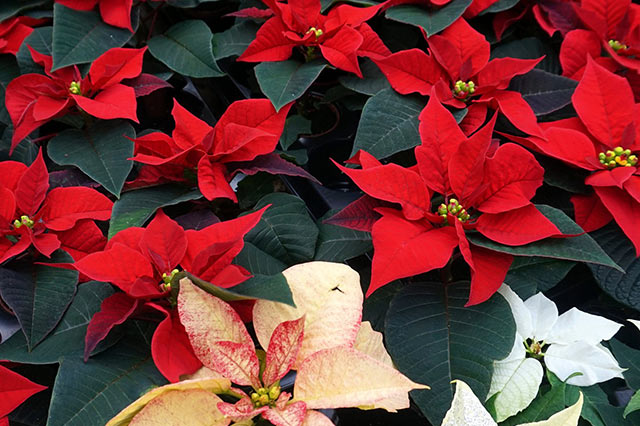
gardeninginfo-online.com gathered information about Poinsettia care after the holiday season and species information to help you keep it thriving.
Poinsettia Care
When the holidays are over, and your Poinsettia(s) start looking tired, you have choices. You can add them to your compost pile, or you can spring into action and care for them!
Poinsettias thrive during the holiday season (fall and winter) because they are short-day plants requiring long nights to launch their color change. The plants’ colorful bracts (almost always red) are leaves, not flowers. The flower buds are the red or green buttons centered in the bracts opening as small, yellow flowers. Consider the following care tips to keep your Poinsettia thriving and looking bright.
Temperature – Poinsettias should be protected from freezing temperatures at all times. Potted Poinsettias do best when:
- Daytime temperatures are kept between 65°F and 70°F
- Nighttime temperatures are kept between 55°F and 65°F
- Kept in a well-lit room
- Kept away from drafts
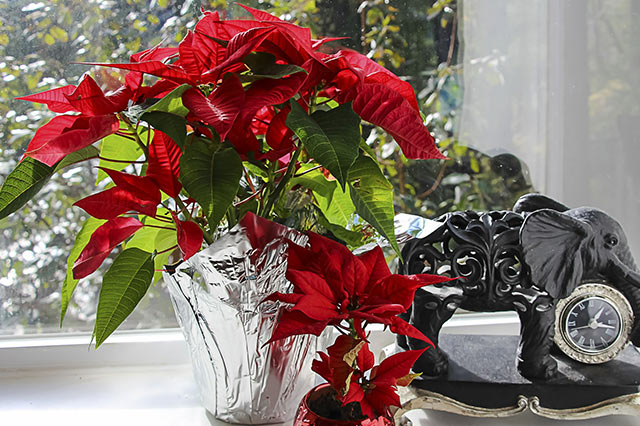
Tip: To avoid damaging the plant, Poinsettias should not be exposed to temperatures below 50°F.
Watering Poinsettias – This species is highly susceptible to root rot and will quickly develop the disease if kept too wet. Observe the following:
- Poinsettias do best when planted in well-drained soil
- Water the plant when the soil feels dry 2 inches down (approximately once weekly)
- When watering, water thoroughly and allow excess water to completely drain from the pot
Tip: Store-bought Poinsettias generally come with their pot wrapped in a colorful plastic or foil wrapping. To prevent root rot, remove the wrapping from the pot or cut the bottom off of the wrapping when you get the plant home.
Fertilizing Poinsettias – No need for special fertilizers, a weekly application of an all-purpose, water-soluble fertilizer will keep your Poinsettia thriving through the holidays and beyond.
Once the bracts begin falling from the plant, reduce watering and fertilization, giving the plant a rest period. This is also the time to trim back the plant.
Poinsettia Pruning – With good care practices, your Poinsettias will persist until late March or early April. Once the bracts begin to fall off, trim the plant down, leaving five or six buds on the stem.
While the plant now resembles a stick, it is alive. When you return to a regular water and fertilizer routine, your Poinsettia will begin to leaf out again around early May.
To keep your Poinsettia small and compact, you should cut it back around mid-July and again in early September. This pruning will encourage branching.
How to Encourage Flowering – In late September or early October, store your Poinsettia in complete darkness from sunset to the following day (14 hours of darkness per day) or 5:00 pm to 8:00 am daily. During the remainder of the day, the Poinsettia should be placed in a sun-filled room. Continue this process until the bracts develop a vibrant color. The red or green flower buds develop in the center of them.
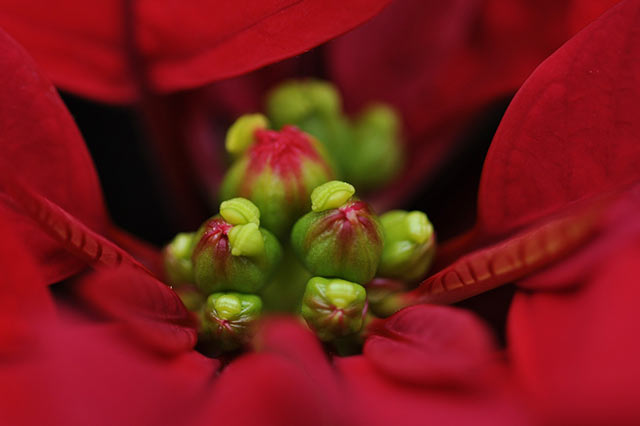
Tip: This routine of giving the plant complete darkness mimics the “short-days” needed to encourage the plant to flower.
Note: Healthy Poinsettias have dark green leaves below the colorful bracts running all the way to each stem’s base.
Poinsettia Facts
A native of southern Mexico and Central America, the Poinsettia (named after Dr. Joel Roberts Poinsett) blooms in December and has been used as a church decoration in that region of the globe for centuries. From the fourteenth to the sixteenth centuries, Aztecs used Poinsettia leaves to dye fabric and its sap for medicinal purposes. The following are species details:
Scientific Name – Euphorbia pulcherrima
Family – Euphorbiaceae or Spurge
Bract colors – Red, pink, white, yellow, purple, salmon, and multi-colored
Characteristics – Bushes or small trees in Mexico and Central America, landscaping shrub, or potted indoor plant (most popular) in the rest of the world.
Nicknames – Lobster Flower and The Flame-leaf Flower
Introduction to the US – 1828 by Joel Roberts Poinsett
Plant Production and Sales – The Paul Ecke Ranch in California produces 70% of all Poinsettias purchased in the United States and nearly half of worldwide sales.
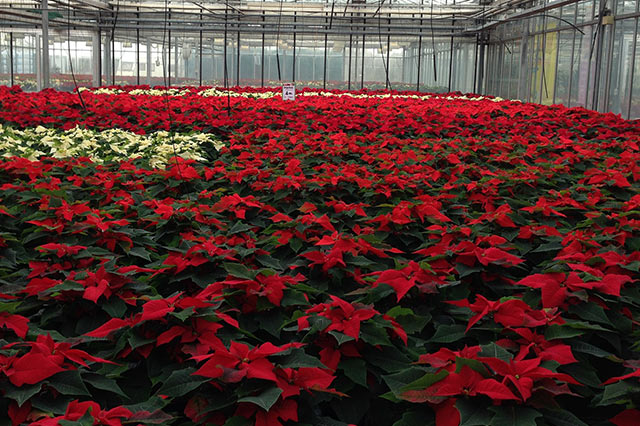
Toxicity – Poinsettias are not poisonous. However, in rare cases, exposure to the eye may cause eye irritation, and skin exposure to the plant’s sap may cause itchiness, redness, and/or swelling.
Diseases – Poinsettias are susceptible to multiple fungal, bacterial, and parasitic diseases that result mostly in root rot, blight, powdery mildew, and cankers. However, infection by Poinsettia branch-inducing phytoplasma is desirable. This disease helps keep the plant shorter with more flowers.
Poinsettia Uses and Significance – The plant is used in religious and cultural ceremonies/events around the globe. Most notably:
- In Mexico and Guatemala, the Poinsettia is called “Flower of the Holy Night” (translated: La Flor de la Nochebuena), referring to Christmas Eve.
- Chileans and Peruvians refer to the Poinsettia as the “Crown of the Andes.”
- In Spain, the Poinsettia has an alternate holiday attribution. It is known there as “Flor de Pascua” or Easter flower.
- The Poinsettia Bowl is an NCAA college football bowl game held in San Diego. The first Poinsettia Bowl was played in December of 1952.
With more than 100 cultivated varieties patented and a quarter billion dollars in annual sales (in the United States alone), the Poinsettia is regarded as the world’s most economically significant potted plant.
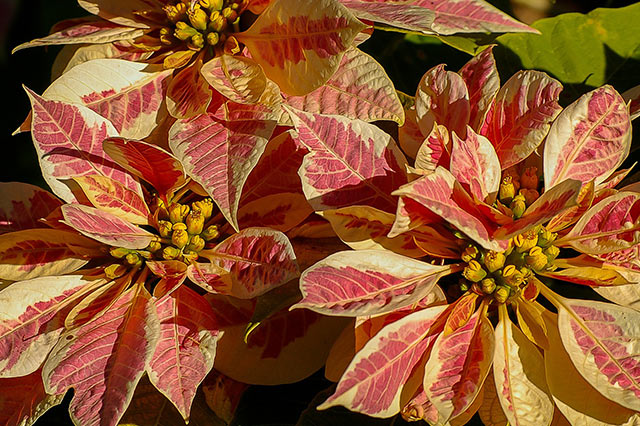
Caring for Poinsettias
In this article, you discovered Poinsettia care and species information to help you keep your plants blooming year after year.
By properly caring for your Poinsettia plants, you can enjoy their beauty and keep them on display practically all year.
Neglecting the needs of your Poinsettia plant(s) will lead to their fast wilting and death.
Sources:
hortnews.extension.iastate.edu/faq/what-should-i-do-my-poinsettia-after-holidays
extension.umn.edu/houseplants/poinsettia
extension.usu.edu/news_sections/home_family_and_food/poinsettia-care
pss.uvm.edu/ppp/articles/points.htm
web.extension.illinois.edu/poinsettia/facts.cfm
The post Poinsettia Care after Christmas appeared first on http://gardeninginfo-online.com.
No comments:
Post a Comment